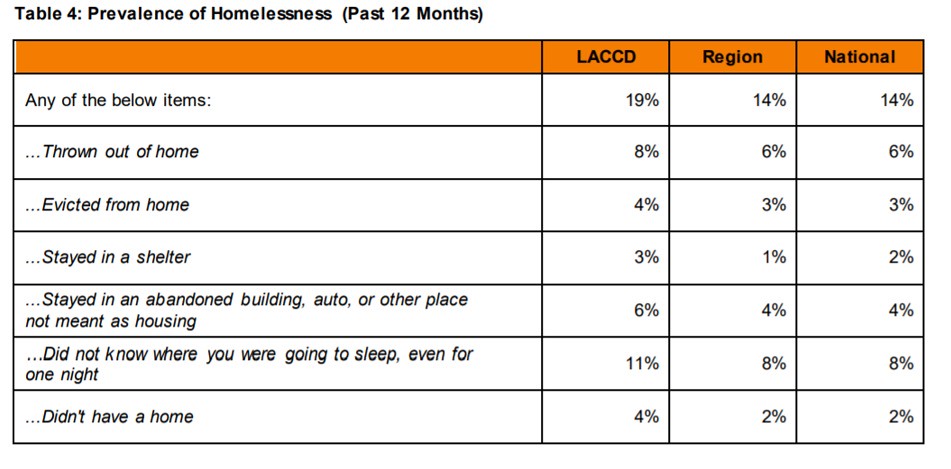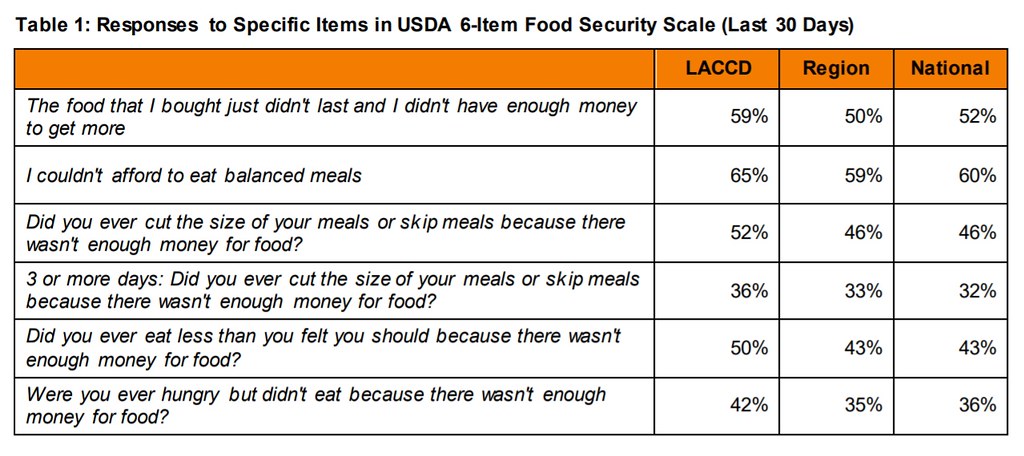
One would not usually associate homelessness with college students but in the Los Angeles Community College District (LACCD) about one in every five students has experienced homelessness, according to the LACCD Report on Survey of Student Basic Needs.
The Los Angeles Community College District is the nation’s largest community college district, serving 250,000 students every year at its nine colleges in Los Angeles County.
The core of the problem in Los Angeles is unaffordability. Los Angeles has the least affordable rental market in the country, based on the portion of renters’ income that goes toward paying rent.
Homelessness
According to the LACCD Report, 19 percent of students in the LA college district experienced homelessness in 2016. Eight percent were thrown out of their houses, four percent were forcefully evicted, and six percent were reported to have lived in abandoned buildings, cars or other unsuitable housing structures.
As stated in the report, “Homeless indicates that a person is without a place to live, often residing in a shelter, automobile, an abandoned building, or outside.” Students are considered homeless if they answered yes to at least one of the following six items in the figure below.

Food Insecurity
The survey also found that 59% of the interviewed students answered affirmatively to the statement, “The food I bought just didn’t last and I didn’t have enough money to get more,” as shown in the figure below. This is a very bothersome scenario which impacts the quality of learning in the District’s higher education sector.

A survey from March 2017 found that one third of community college students (from a sample of more than 33,000 students at 70 community colleges in 24 states) go hungry. Sara Goldrick-Rob, who led the research team said, “Not only did we find challenges of food insecurity and housing insecurity at the less expensive community colleges, we found it at more expensive colleges. We found it at urban schools and rural schools. It’s all over the place.” The study’s researchers advise colleges to partner with local homeless shelter and food banks to better address students’ needs.
Recommendations
To better understand this problem, we have to look at the origin and larger trends. Several regions are facing the same situation where affordable housing becomes out of reach for the poor and even middle-income families. According to the 2015 Community Learning Partnership (CLP) report, housing inflation and gentrification were found as part of the problem that has led to the student housing crisis and increase in homelessness.
This becomes an even more disturbing trend when the figures keep rising:
“Studies show that one major reason for the high dropout rate in community colleges is the shortage of affordable housing for students. In 2014, over 56,000 U.S. college students were classified as "homeless" and this number counts only those students who are registered in homeless shelters or identify themselves as homeless. This figure has increased 75% over the last three years. It is part of a larger picture: there currently are 1.3 million homeless young people in the U.S. This is double the figure for 2008.”
CLP, together with CD Tech, a partner community-based nonprofit organization with 20-years of housing issues experience, are seeking solutions for the student housing crisis in the LA community college district.
Efforts have been made to provide affordable housing units through strategies like Measure H to fight homelessness in LA County. LACCD’s Financial Aid Plan proposes to offer waivers, grants and other forms of support to needy students. However, the details of these projects have not been established yet.
Campus food pantries are “an idea whose time has come,” the executive director of the Orange County Food Bank Mark Lowry said in a recent interview, as more universities in the Cal State system are adding food pantries to their campuses in order to combat the student hunger issues. Approximately 540 campus food pantries have been registered with the College and University Food Bank Alliance, which is closely monitoring the trend across the U.S.
Some food pantries in the campuses are run and managed by paid staff and on a budget while others depend partly or entirely on donors and volunteers. Others started off in tiny closet-sized compartments and have grown into multi-department establishments. UCLA food bank is dubbed the Food Closet and UCI recently remodeled its pantry to over 1,800 square feet, making it the biggest in the UC system. Not only does it offer free food and toiletries, but also sitting areas, a kitchenette with some handy appliances, and a showroom for weekly nutrition talks and food demonstrations.
Recommendations were also made to college officials to at least provide basic hygiene facilities such as showers and restructure openings to public benefits, as well as other resources that could make living conditions tolerable to students in need.
Family Background
Students who come from poor backgrounds, especially foster care students and those coming from homeless families, are especially vulnerable to food insecurity and homelessness.
California’s cash welfare, CalWORKs, offers an aid of $714 per month to families with two kids in order to help pay rent and other sustenance needs. However, this amount does not cover the rent requirements even for low-income housing units which exceed the aid by $150 generally in California and $256 in Los Angeles, the highest per unit low-income housing rent charges.
All this is occurring amidst an upsurge in new college enrollment among low-income students. Most of the colleges seem to systematically miscalculate the off-campus living cost and conditions for students.
The housing problem for college students is a core issue linked to the access to safe and adequate food and nutrition. Thorough research has been conducted and factors responsible have been identified, they remain complex to eliminate. It does not serve society well for so many young people, particularly from working-class families, to face such harsh and debilitating conditions.
Kevin Nelson is a professional educator and a private tutor with over eight years of experience. He is also a content writer for various blogs about higher education, entertainment, social media & blogging. Feel free to connect with him on Twitter, LinkedIn & Google+, and his website, https://eliteessaywriters.com/.












